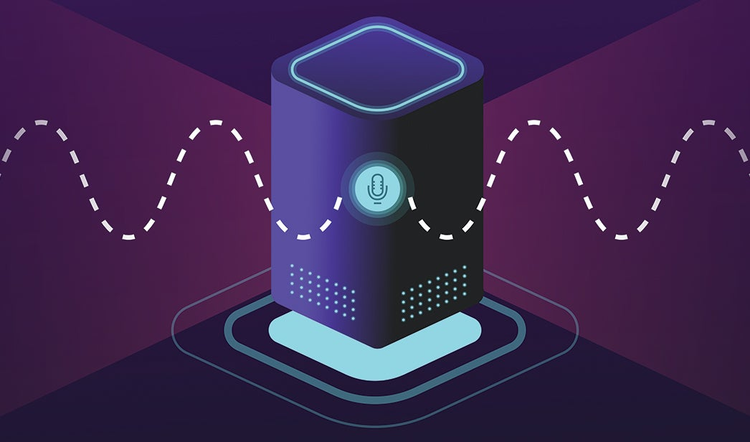Consumers are talking back to brands, and increasingly they’re saying, “Purchase.” That’s just one of the highlights from a new survey of 1,025 U.S. consumers about voice services, conducted by Adobe Digital Insights.
Consumers are talking back to brands, and increasingly they’re saying, “Purchase.”
That’s just one of the highlights from a new survey of 1,025 U.S. consumers about voice services, conducted by Adobe Digital Insights (ADI). Analysis also found that voice ads are gaining credibility, voice commerce is showing promise, and if we’re going to talk to a device, we’d prefer a celebrity voice talk back to us.
“We’re finding that consumers are starting to us voice to make purchases, and also that voice commerce supports activities related to purchases and the overall shopping journey as well,” said Colin Morris, director of Adobe Analytics.
Among the survey’s main points:
• Voice ads are a credible alternative to other formats: A growing number of consumers appear to be more amenable to voice advertising. In the ADI survey, 43% of respondents stated they find voice ads less intrusive compared with TV, print, online, and social—up from 38% in January—and 42% found voice ads to be more engaging, up from 39%. That’s promising news since according to Juniper Research, 2.5 billion voice assistants were in use at the end of 2018, and that number is expected to more than triple by 2023.
“Voice ads have the power to resonate more emotionally and personally with a customer,” Morris says. “The control is put back into the hands of the consumer with ads delivered based on the information they opt to provide to us making the content delivered relevant and engaging, enhancing the customer experience.”
Also notable, 39% of people who heard a voice ad later went on to purchase the item. In addition, 35% don’t skip through voice ads, suggesting people will listen to voice ads as a trade-off for a free service.
• Voice shopping, while nascent, is showing potential: If you’re one of the billions of people with a voice assistant, you’ve likely asked it to play music, tell you the weather forecast, or search for information. For 20% of survey respondents, voice shopping can be added to that list.
“Convenience is top priority for today’s customers, and voice-activated shopping makes conducting research and making purchases that much more efficient and hands-free,” Morris said. “Rather than having to click through on a computer or mobile device, they can simply engage in a conversation to initiate the purchase or recurring purchase.”
Twenty percent of smart speaker owners reported having already shopped or ordered an item via voice, with 15% reordering frequently bought items. In addition, 61% said they would use voice to purchase recurring, “lightweight” household items.
So far, if given the option, consumers would be most comfortable buying recurring household items and services via voice, such as groceries (31%), cleaning supplies (29%), entertainment (24%), clothing (24%), and home delivery meals (24%).
Expanded functionality in the future will help drive consumer adoption, with 44% of consumers stating they would make a new or additional purchase if more brand made voice commerce and option.
“If brands start by using voice as a medium that sits on top of mobile, they can create an experience consumers didn’t have before,” Morris said.
Purchase-related activities via voice include conducting a product search (40%), creating shopping lists (30%), conducting a price comparison (25%), and checking an order status (19%).
• Voice activities are just getting started: Though 72% of smart speaker owners use their device at least daily, they’re not jumping right to commerce. The top reasons for use are music (72%), weather (59%) and, well, simply asking fun questions (55%).
Over the past 10 months, “emerging use cases” like game play and food delivery haven’t seen significant growth, but those who do leverage those activities are highly engaged. Of those who check and manage their finances, 52% check in daily. Meanwhile, 40% use voice for food delivery.
“The lag in growth of shopping and commerce via voice assistants could be because there is yet to be a ‘killer app’ on voice,” Morris says. “The demand is there—now it’s just a race to see which brand captures the opportunity first.”
• Voice control desired across different products: Consumers consider voice capabilities an important factor in what they’re purchasing. Advances in voice recognition technology are driving demand across different products. Thirty-one percent said they look for voice technology incorporated into products when shopping for cars (31%), music speakers (30%), general electronics (26%), and TVs (25%).
What’s more, people actually like their voice assistants. Twenty-eight percent say that the voice assistant on their smartphones has become an indispensable feature, with 44% using it at least daily.
What are they using it for on their phones? The most common activity is to search online (50%), followed by getting directions (45%), the weather (39%) and composing text messages or making a call (38%).
• Celebrity voices emerge by popular request: The default voice for voice assistants has long been female, but now different brands have expanded their offerings to include male and female voices, and with various accents. In addition, nearly a third of respondents (32%) stated they would enjoy the option of choosing a celebrity voice. Dwayne “The Rock” Johnson was most frequently cited, at 47%, followed by Will Smith (43%) and Arnold Schwarzenegger (35%). Oprah made the list with 30%.
Alexa, cover your ears.
View the full study below or click here to view it on SlideShare.
https://www.slideshare.net/slideshow/embed_code/key/sgFvKtiezdO0rG

